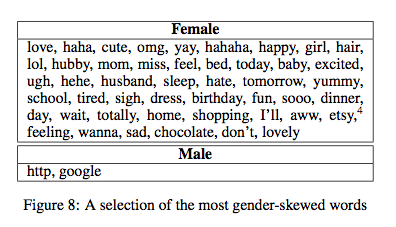Gender roles have been ingrained in society since before the advent of time. Well…at least long before the advent of social media.
Western Civilization has always been influenced by the social construct. In Shakespeare times, the masculine and feminine expression went mainstream through the play, Much Ado About Nothing. Shakespeare typified the ideal woman as a beauty – respectful, demure, nurturing and loving. Men, on the other hand, were depicted as strong, independent and vulgar. 
While some of Shakespeare’s themes can be endlessly interpreted and remixed, his view on gender was written in undeniable ink.
Fast forward a few hundred years, and the “traditionally male” and “traditionally female” roles penned during the Elizabethan Era remain unchanged in the data-driven social media information age of today.
A recent study from Carnegie Mellon University entitled, “Gender in Twitter: Styles, Stances and Social Networks,” looked at data from more than 14,000 Twitter users in the U.S. Conducting the study over the course of six months, the researchers looked at more than 9,212,118 Tweets from both men and women, and discovered that the gendered styles of communication ring true, even within a 140 character limit.
According to the study, the women Tweeted a relatively large number of “emotion-related” terms – think Emoticons, a propensity for terms like “LOL,” and “OMG,” and expressive language as represented by exclamation marks, question marks, and backchannel sounds like, “Ah,” and, “Coooool.”
Men, on the other hand, were observed Tweeting about technology or sports – including several numeric “tokens,” like 1-0, which will often indicate the score of sporting events. Swears were more common among the male users, and they tend to communicate more about hobbies and careers than emotion-based discourse.
By delving deeper into these statistical differences, the researchers eclipsed “the men are from mars, women are from venus” model, and were able to draw some interesting conclusions regarding the language used in the Twittersphere and life offline.
As the study explained, the social networks created by following or replying to other users reveals some disarmingly accurate predictions about one’s personal attributes (e.g., Thelwall 2009). The research found that men who tweeted more “male” words were likely to have more men in their network, and the same was found for women. The statistical outliers of the study who employ language more typical of the “opposite sex,” are more likely to have networks skewing to the other gender.
Linguistics reinforcing gender bias? You be the judge.




Recent Comments